The 2015 major El Nino was predicted years in advance using a lunar cycle

By Javier Vinós
In 2007, two Canadian scientists studying the effects of this cycle on the Pacific coast of North America successfully predicted the occurrence of a major El Niño event in 2015 based on lunar data. Remarkably, their prediction proved accurate.
The Earth’s oceans contain a vast mass of cold water beneath a thin layer of warm water, and the limited amount of mixing between them plays a crucial role in our existence. Tides, primarily influenced by changes in the moon’s orbit, are the main force behind this mixing, which has the potential to cool the climate. Keeling, who pioneered CO2 measurements, believed in this theory and predicted a cooling trend for the next decade. The impact of the 18.6-year lunar cycle on climate has been known for some time, but more recent research has revealed its influence on the El Niño Southern Oscillation (ENSO).
The potential uniqueness of the Earth-Moon system
When astrophysicists discuss the abundance of potentially habitable planets around Sun-like stars, they often overlook a crucial fact: Earth’s formation was probably an incredibly rare event. About 4.5 billion years ago, our planet was born from a chance collision between early Earth and a Mars-sized planet. This serendipitous event explains two extraordinary features of Earth that may be exceptionally rare among other Earth-like planets. The first remarkable feature is Earth’s large metallic core, which generates a strong magnetic field despite the planet’s size. This magnetic field plays an important role in protecting our atmosphere from the solar wind, preventing the loss of light gases. The second unusual aspect of Earth is that it has an unusually large satellite for its size. Normally, the mass ratio between a planet and its satellite is about 1:10,000. However, the Earth-Moon system has a mass ratio of only 1:81, so close that it is sometimes referred to as a double planet.
The presence of such a large satellite exerts a powerful influence on Earth. It may have been essential to the presence and maintenance of complex life over time. The gravitational pull of the Moon stabilizes the tilt of the Earth’s axis. If a small change in the tilt of as little as 2.4° leads to a glaciation, Earth’s climate may have been too unstable for complex life to evolve under much larger tilt changes without the Moon.
The main effect of the Moon on the Earth is thus mediated by gravity, one of the most powerful forces in the universe, which has the capacity to significantly affect climate through the tides it produces in the ocean, atmosphere, and crust.
Tides’ effect on climate
The Moon’s orbit is tilted by 5° relative to the Earth’s orbital plane, also known as the ecliptic. The points where the Moon’s orbit intersects the ecliptic are called nodes. Eclipses occur only when the Moon is near a node and the line connecting the two nodes is aligned with the Sun. This alignment occurs approximately every six months, creating an eclipse season.
However, the Moon’s orbital plane around the Earth undergoes a gradual precession that causes one of the nodes to complete a full rotation relative to one of the equinoxes over a span of 18.61 years. This phenomenon is called the lunar nodal cycle. As a result of this precession, the 5° tilt of the Moon’s orbit is either added to or subtracted from the Earth’s axial tilt, resulting in a change in the Moon’s declination (its position relative to the equator). This declination varies from a maximum of 28.5° during a major lunar standstill to a minimum of 18.5° during a minor lunar standstill, completing a full cycle over the course of 18.61 years. These changes affect tidal patterns.
Tides are a complex phenomenon. As a result of the Moon orbiting the Earth in the same direction as the Earth’s axial rotation, it takes 24.84 hours for the Moon to be over the same position, so there is a semidiurnal tide every 12.42 hours. But this is only one of the many constituents of the tides, and it is called M2 (M for Moon and 2 for being semidiurnal). The next constituent in strength is due to the lunar-solar declination. It is diurnal with a period of 23.93 hours, and it is called the K1 constituent
Since the strength of this diurnal tidal constituent is directly related to the declination of the Moon over the Earth’s equator, we observe an 18.6-year cycle in the strength of the lunisolar diurnal tide. The semi-diurnal tides are also affected but to a lesser extent. For example, the amplitudes of the largest diurnal and semi-diurnal tidal constituents, K1 and M2, vary by 13% and 5%, respectively, over an 18.6-year cycle.
The lunar nodal cycle influences surface ocean temperatures through vertical mixing, which is influenced by increased or decreased tidal currents depending on the phase of the cycle. Numerous studies analyzing oceanic and atmospheric time series have identified an 18.6-year cycle in sea surface temperature and sea level pressure at various locations in the Pacific and other regions. There is a large body of literature on this topic.
In the Pacific, two notable low-frequency oscillations affect sea surface temperature and sea level pressure. The first and most widely known is the Pacific Decadal Oscillation (PDO). However, there is also a shorter-period low-frequency oscillation known as the North Pacific Bidecadal Oscillation. This oscillation was first discovered in Alaska in 1998. A year later, in 1999, Shoshiro Minobe established a correlation between the PDO and the Bidecadal Oscillation, showing that both oscillations occur in synchrony.[1]
Figure 1a shows the North Pacific Index (NPI) during winter (December to February). The NPI serves as an indicator of sea level pressure changes in the Aleutian Low, a large region in the North Pacific. It has a strong correlation with the Pacific Decadal Oscillation (PDO). When the PDO is reflecting colder temperatures, the NPI is showing higher pressure patterns and the other way around. The graph contains two data sets with Gaussian smoothing. The thick solid line emphasizes the long-term, multi-decadal variation, while the thick dashed line represents the shorter-term, bidecadal variation.

Figure 1. Multidecadal oscillations of the North Pacific Index. (a) Winter NPI data and two Gaussian smoothing. (b) Wavelet analysis.
Figure 1b from Minobe 1999 shows a wavelet analysis of the data. The graph illustrates time on one axis and frequency on another, while the third dimension is represented by the color scale indicating the pressure anomaly measured in hPa. This analysis allows us to identify two prominent oscillations: one occurring every 60 years and another every 20 years. In particular, significant climate shifts that cause sudden changes in the climate and ecology of the Pacific, such as the one in 1976 that triggered global warming, coincide with a simultaneous phase change in both oscillations.
Dave Keeling’s little-known tidal research
The ocean plays a critical role in moderating surface temperature variations on our planet. This fact is evident when comparing the greater seasonal temperature variations observed in continental climates compared to oceanic climates. Our existence depends on the lack of significant mixing between a thin layer of warm water, only a few hundred meters thick, on top of an icy cold ocean with an average temperature below 4°C. Even a small increase in vertical mixing could be catastrophic. It is clear, then, that vertical mixing in the ocean has the potential to be a climatic factor. The only two forces that can influence this vertical mixing are the wind and the Moon, as they contribute the necessary mechanical energy to the ocean. The Moon contributes about 4 TW (terawatts) of energy, while the wind contributes about 2 TW.
Charles David Keeling (1928-2005) was an outstanding scientist. In the late 1950s, he established a meticulous system for accurately measuring the background concentration of CO2 in the atmosphere. Keeling’s dedication quickly led to the discovery that these concentrations were steadily increasing. Despite several attempts to shut down the Mauna Loa station due to budget cuts, he single-handedly ensured its continued operation. Many considered this ongoing effort costly and routine, but Keeling’s persistence prevailed. In recognition of his remarkable scientific achievements, he was awarded the 2002 National Medal of Science, the highest lifetime honor for scientific achievement in the United States. The atmospheric CO2 record at Mauna Loa, known as the “Keeling Curve,” was designated a National Historic Chemical Landmark in 2015.
It is not widely known that Dave Keeling, in his later years of research, focused on the Moon as a means of understanding climate variability on Earth. While he firmly believed that CO2 increases were the cause of global warming, he sought to identify additional factors that could account for previous cooling periods that could not be explained by CO2 changes. Keeling theorized that changes in the Moon’s effect on ocean mixing could affect surface temperatures – a simple and scientifically sound mechanism. The only question is the magnitude of the effect of these changes.
Figure 2 is taken from a 1997 article by Keeling.[2] The strongest tides occur under certain circumstances: (1) during a Sun-Earth-Moon syzygy or alignment, (2) when the Moon is at its closest point to the Earth (perigee), (3) when the Moon is at one of the nodes of the Earth’s ecliptic, and (4) when the Earth is closest to the Sun (perihelion). On average, these conditions coincide about every 1800 years (1682, 1823, or 2045 years ± 18 years). However, harmonics and shorter periodicities occur when only a subset of these conditions are met.
The figure illustrates a 93-year cyclic pattern in tidal amplitude resulting from the succession of five nodal cycles. It’s important to note that tidal forcing does not increase continuously over decades. Rather, it increases on some days during a few lunar months when alignments occur, as indicated by the vertical lines in the figure. After that, the tidal forces may average out in the following years, only to regain strength 18 years later. The arcs connecting the peaks in tidal force are provided only as a visual aid to show the recurring pattern separated by an 18-year interval.

Figure 2. Timing of lunisolar tidal forcing since 1600 AD. Each event, indicated by a vertical line, gives a measure of the forcing in terms of the angular velocity of the Moon, in degrees of arc per day. The gray bars correspond to cool climate episodes.
This figure was reproduced in my book when I explained how tidal forcing is a likely candidate for triggering the Dansgaard-Oeschger events during glacial periods.[3]
Keeling and co-author Timothy Whorf made an interesting observation about the alignment of significant increases in tidal forcing over the last 400 years. They noticed a correlation between these periods and the cool periods documented in a separate publication by Phil Jones, the former director of the Hadley Climate Research Unit (HadCRU). These cool periods are represented by the gray bars at the top of Figure 2.
While it may be unreasonable to claim that the cooling climate of these periods was caused solely by the increase in tidal forcing, it is plausible to consider that tidal forcing played a role in enhancing the cooling effect beyond what would have occurred in its absence. They projected another peak in tidal forcing in the coming 2030s (labeled “D” in the figure). This should coincide with my projection of a temperature drop due to the coincidence of low solar activity and the transition of the Atlantic Multidecadal Oscillation into its cold phase. Nature has yet to show its true strength to overconfident climate modelers.
The Moon as an El Niño predictor
In 2007, two Canadian scientists, McKinnell and Crawford, conducted a study examining the relationship between the lunar nodal cycle and various factors such as air temperatures, sea surface temperatures, and 400-year tree ring records along the Pacific coast of North America.[4] One notable finding they made was the correlation between winter sea surface temperatures measured at Scripps Pier in San Diego, California, and the tidal constituent K1, which influences diurnal tidal amplitude. Figure 3 shows this relationship.

Figure 3. Mean January sea surface temperature anomalies at Scripps Pier superimposed on the diurnal lunar nodal cycle. Red circles, marking some El Niño years, have been added to the original figure.
Remarkably, the strongest positive January temperature anomalies at Scripps Pier consistently coincided with a lunar nodal cycle minimum. On the other hand, the lowest anomalies were often, though not always, observed within a year or two of a nodal cycle maximum.
McKinnell and Crawford also observed a remarkable synchronization between the lunar nodal cycle and some of the largest El Niño events of the 20th century, such as those in 1940/41, 1957/58, and 1997/98. Attributing the cause of El Niño solely to the Moon would be inaccurate, as there are instances (e.g., 1972/73, 1982/83) when El Niño events do not align with the nodal cycle.
Nevertheless, the relationship between the 18.6-year lunar cycle and El Niño had already been described in a 2001 article and has been further emphasized in recent studies.[5] [6] The explanation presented in the 2001 article suggests that tidal forces acting on the Pacific gyre modify the transport of cold water into the equatorial region, thereby influencing the likelihood and magnitude of El Niño events.
Even in the absence of a major El Niño event, the Scripps Pier data presented in Figure 3 show the presence of consecutive Niño episodes during lunar nodal cycle minimums. These are the Niño events of 1940/41 and 1941/42, 1957/58 and 1958/59, and 1976/77 and 1977/78.
Based on the available data, the authors suggest that the coincidence between the North American coastal sea surface temperature response to the lunar nodal cycle and El Niño events deserves greater attention, particularly if a strong El Niño occurs around 2015.
Given the challenges associated with predicting the occurrence of an El Niño event, let alone its magnitude, it is truly remarkable that the authors were able to successfully predict a major El Niño eight years in advance. Even more amazing is the fact that this prediction was based on the 18.6-year lunar cycle. It is recommended that anyone involved in ENSO forecasting take into account the accumulated knowledge of the Moon’s influence on ENSO. While not a hard and fast rule, it is apparent that the likelihood of a major El Niño event, or even successive Niño episodes, is higher for 2034. Such an event could potentially mitigate the expected cooling trend.
[1] Minobe, S., 1999. Geophys. Res. Lett. 26 (7), pp.855–858. doi.org/10.1029/1999GL900119
[2] Keeling, C.D. & Whorf, T.P., 1997. PNAS, 94 (16), pp.8321–8328. doi.org/10.1073/pnas.94.16.8321
[3] Vinós, J., 2022. Climate of the Past, Present and Future: A scientific debate. 2nd ed. Critical Science Press.www.amazon.com/dp/B0BCF5BLQ5 Also in French www.amazon.fr/dp/B0BRJ94Z2H/
[4] McKinnell, S.M. & Crawford, W.R., 2007. J. Geophys. Res. Oceans, 112 (C2). doi.org/10.1029/2006JC003671
[5] Cerveny, R.S. & Shaffer, J.A., 2001. Geophys. Res. Lett. 28 (1), pp.25–28. doi.org/10.1029/2000GL012117
[6] Yasuda, I., 2018. Sci. Rep. 8 (1), p.15206. doi.org/10.1038/s41598-018-33526-4




